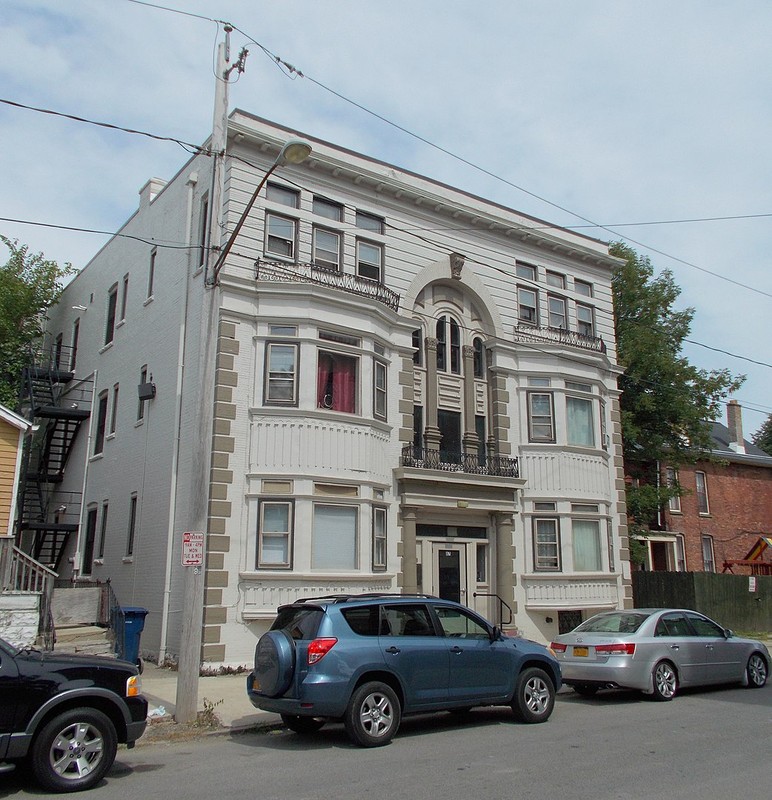Karnak Flats
Introduction
Text-to-speech Audio
Images
2016 Photo of Karnak Flats in Buffalo, New York

Backstory and Context
Text-to-speech Audio
Karnak Flats (circa 1898) survives as a significant example of a late nineteenth-century Buffalo apartment building. The Colonial Revival style apartments arose during a period of robust growth in apartment construction as middle- and upper-class professionals (usually young) sought quality suburban housing. Between 1896 and 1900, real estate developers constructed 133 apartment buildings whose clientele almost exclusively belonged to the wealthier classes.
For most of America's existence until the Civil War, apartment living enjoyed little popularity. A spacious (and expanding), mostly agrarian country where owning land enjoyed substantial value culturally, politically, and economically, prevented much need or desire for multi-dwelling living. However, the late nineteenth-century industrialization and urbanization (along with increased immigration) led to a need for cheaper residential buildings, notably in massively growing cities like New York. As cities continued to thrive, populations grew immensely, leading to soaring property values and decreased land availability. Thus, apartments eventually catered to every class, with wealthy residents moving into ornate, spacious apartments filled with amenities. As cities grew overly congested and dirty around the turn of the twentieth century, residents with financial means took advantage of the advances in transportation such as local trains that connected cities to growing suburbs. And eventually, the automobile made its presence felt in American culture. Thus, residents moved away from the city to outer suburbs. The urban mindset and acceptance of apartment living continued to make apartment development a popular choice in the suburbs, notably among young professionals and newly married couples.
The Karnak Flats mirrored the broader, national trend in apartment living. The Flats emerged in a well-established suburb that formed shortly after the Civil War. Moreover, construction of the apartment complex occurred roughly the same time Buffalo and vicinity first received electricity from Niagara's waters; the city and nearby suburbs increasingly became electrified. The spacious layout of the Karnack Flats speaks to the financial makeup of its residents. The design consisted of two apartments per floor, each with seven rooms. And, each residence contained a host of modern amenities.
Still, Karnak tenants stayed for a relatively short period before moving even further from the city to newer suburbs developed during the economic boom of the 1920s. Thus, skilled and unskilled workers begin to displace the wealthy residents at Karnak. As the socioeconomic makeup of the complex changed, so did the layouts. The apartments were divided in half during the 1930s (Great Depression) so that more residents filled the building, but all enjoyed less space. Each passing decade, notably because the apartments showed their age, the tenants' economic makeup continued to move towards the impoverished; by the 1970s, the Karnak functioned as public housing.
Like most cities during the twenty-first-century, there's been an increase in renovating nineteenth-century structures, turning them into apartments and retail spaces. The Karnak Flats sold in 2014 for $4,316,290, and the building again serves as an apartment complex.
Sources
Modell, John. "Suburbanization and Change in the American Family." The Journal of Interdisciplinary History 9, no. 4 (1979): 621-46. Traynor, Kerry. "Nomination Form: The Karnak Flats." National Register of Historic Places. nps.gov. December 13, 2016. https://www.nps.gov/nr/feature/places/pdfs/16000841.pdf.
By Pubdog - Own work, CC BY 2.0, https://commons.wikimedia.org/w/index.php?curid=50283632
